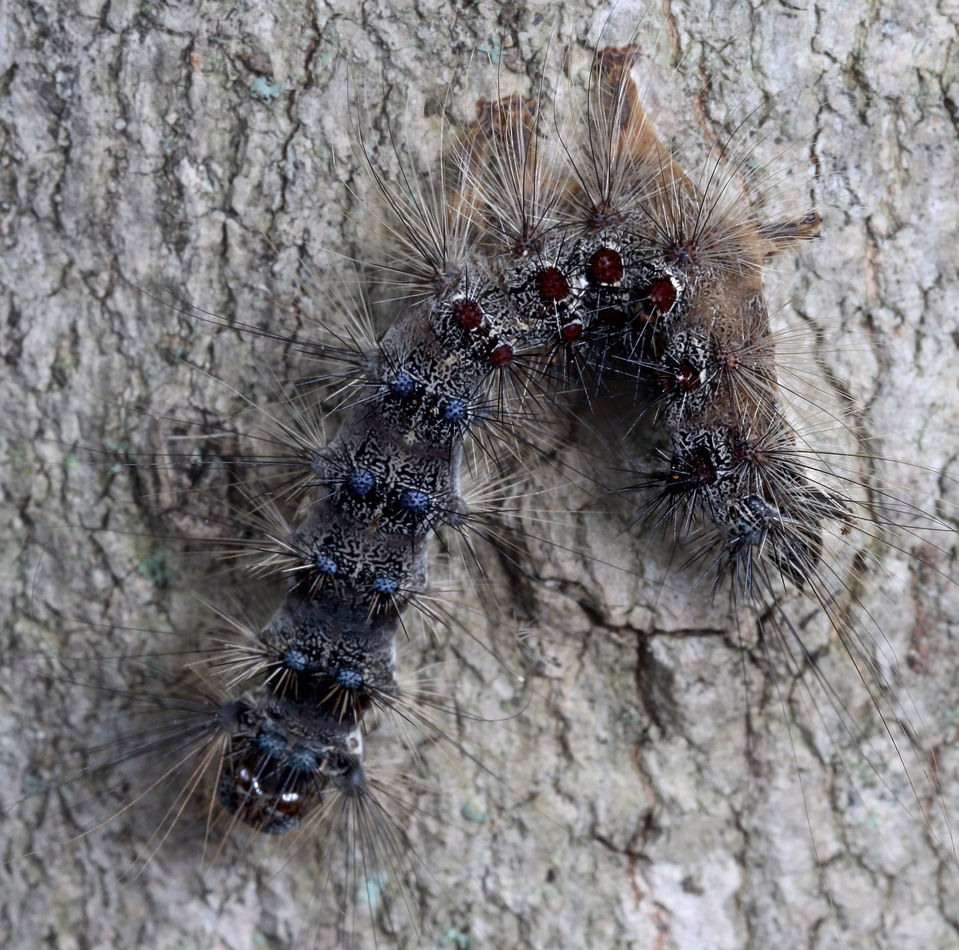I don’t like “gypsy moths”
Jan 23, 2022 12:53:47 #
The invasive European gypsy moth (Lymantria dispar dispar) has been in my area of Michigan for several years. I used to see one or two a season, but now they are becoming extremely common. The name “gypsy moth”, by the way, is being removed from public view since some consider the name to be offensive to the Romani people. I usually roll my eyes at such displays of performative Wokeness, but in this case I've come around to understanding why this particular name is a problem. Since no new common name has appeared, however, I will use the old common name for this post. Wikipedia still uses it too.
Here is a caterpillar. Mature caterpillars like this one are common on tree trunks, and there they will form a flimsy cocoon that is protected by their irritating hairs. Its common to see several cocoons, some piled on top of each other, lining the furrows of tree bark.
 European gypsy moth by Mark Sturtevant, on Flickr
European gypsy moth by Mark Sturtevant, on Flickr
 Lymantria dispar by Mark Sturtevant, on Flickr
Lymantria dispar by Mark Sturtevant, on Flickr
Male moths will often be seen perched alertly like this, using their ginormous antennae to sniff out female pheromones. One must admit that their headgear is impressive.
 Lymantria dispar by Mark Sturtevant, on Flickr
Lymantria dispar by Mark Sturtevant, on Flickr
 Lymantria dispar by Mark Sturtevant, on Flickr
Lymantria dispar by Mark Sturtevant, on Flickr
Females are rather odd. They don’t fly but instead continue to rest on tree trunks near their cocoons. Once mated, they make an egg mass that is covered by body hairs as shown here. This tree was dotted with females as far as I could look up, and all the trees nearby were just like it. Here they will sit until they die. Females in my area tend to have asymmetrical wings, but they don’t fly so it does not matter. Their egg masses have helped gypsy moths to spread across the Eastern US via transport on timber, firewood, and on anything else that moves.
 Lymantria dispar by Mark Sturtevant, on Flickr
Lymantria dispar by Mark Sturtevant, on Flickr
 Lymantria dispar by Mark Sturtevant, on Flickr
Lymantria dispar by Mark Sturtevant, on Flickr
Gypsy moths were introduced into the Eastern US in the 1800s by an idiot who wanted to see if they could be useful for the silk industry. The larvae feed on a very large range of hardwood tree species, and when their populations reach plague proportions they will do considerable damage by defoliation. That has not happened here as far as I’ve seen, but I don’t know what the future will be.
On a brighter note, I do see a lot of dead gypsy moth caterpillars. Large numbers succumb to what I suppose is a bacterial disease, and so later in the summer I often heartened to see lots of them hanging limp and dead like this one.
In closing, I am inspired to paraphrase Bette Davis.
“One should never say bad things about the dead. You should only say good.
This gypsy moth caterpillar is dead.
Good. “
Here is a caterpillar. Mature caterpillars like this one are common on tree trunks, and there they will form a flimsy cocoon that is protected by their irritating hairs. Its common to see several cocoons, some piled on top of each other, lining the furrows of tree bark.
 European gypsy moth by Mark Sturtevant, on Flickr
European gypsy moth by Mark Sturtevant, on Flickr Lymantria dispar by Mark Sturtevant, on Flickr
Lymantria dispar by Mark Sturtevant, on FlickrMale moths will often be seen perched alertly like this, using their ginormous antennae to sniff out female pheromones. One must admit that their headgear is impressive.
 Lymantria dispar by Mark Sturtevant, on Flickr
Lymantria dispar by Mark Sturtevant, on Flickr Lymantria dispar by Mark Sturtevant, on Flickr
Lymantria dispar by Mark Sturtevant, on FlickrFemales are rather odd. They don’t fly but instead continue to rest on tree trunks near their cocoons. Once mated, they make an egg mass that is covered by body hairs as shown here. This tree was dotted with females as far as I could look up, and all the trees nearby were just like it. Here they will sit until they die. Females in my area tend to have asymmetrical wings, but they don’t fly so it does not matter. Their egg masses have helped gypsy moths to spread across the Eastern US via transport on timber, firewood, and on anything else that moves.
 Lymantria dispar by Mark Sturtevant, on Flickr
Lymantria dispar by Mark Sturtevant, on Flickr Lymantria dispar by Mark Sturtevant, on Flickr
Lymantria dispar by Mark Sturtevant, on FlickrGypsy moths were introduced into the Eastern US in the 1800s by an idiot who wanted to see if they could be useful for the silk industry. The larvae feed on a very large range of hardwood tree species, and when their populations reach plague proportions they will do considerable damage by defoliation. That has not happened here as far as I’ve seen, but I don’t know what the future will be.
On a brighter note, I do see a lot of dead gypsy moth caterpillars. Large numbers succumb to what I suppose is a bacterial disease, and so later in the summer I often heartened to see lots of them hanging limp and dead like this one.
In closing, I am inspired to paraphrase Bette Davis.
“One should never say bad things about the dead. You should only say good.
This gypsy moth caterpillar is dead.
Good. “
Jan 23, 2022 13:09:42 #
Jan 23, 2022 13:28:15 #
Jan 23, 2022 13:38:49 #
Jan 23, 2022 14:23:29 #
Jan 23, 2022 15:09:21 #
Old Coot wrote:
If it's always been balled a "Gypsy Moth" why would we change it ?
I don't have an answer to that that will entirely make sense to everyone, since people can have their own opinions and that's fine. But for what its worth the term "gypsy" has been long used as a slur (although often its used as a benign term as well). As many will know, there is this effort from the far Left to purge our language of words and names that have negative associations. I don't agree with most of that stuff, personally. For example, the great ornithologist John James Audubon has a large number of species named after him, and there is this effort to change all of those names (!) simply because he expressed commonly held views that are recognized today as racist. I flat out don't agree with that effort!
In the case of this moth, I can just barely see why it should be changed in that I can see both sides of whatever argument there is about it. Its' going, and I won't care either way.
Then there are species with names that are definitely bad and should be changed. There is squaw root and squaw fish, and some even worse than that. Most people are on board with re-naming those since there is wider agreement today that those names are antiquated slurs.
Jan 24, 2022 05:40:01 #
Excellent photos of a particularly hated species. Here in New Jersey they have been very bad off and on for the past 40 years or so. Some years it would be recommended to wear a hat or use an umbrella when walking through wooded areas like much of my property. It would actually sound like it was raining, that was the caterpillar poop falling all around. They would completely defoliate oak forests. most of the trees might survive one year but we lost many if the Gypsies were left unchecked. Back then they sprayed Bt (Bacillus thuringiensis) from aircraft. The Bt is not harmful to mammals but probably kills other insects that may be beneficial or desirable. I hope it doesn't get as bad in MI as it was in NJ.
Jan 24, 2022 08:02:10 #
JimmyTB wrote:
Excellent photos of a particularly hated species. Here in New Jersey they have been very bad off and on for the past 40 years or so. ...
That is what one can be concerned about!
Bt dust is a remarkable natural insecticide. It is a kind of gut bacteria that can be mass produced and dried into a dormant powder. It specifically kills caterpillars and some other kinds of larvae that eat it, so the idea is that by spraying it on leaves it gets into the guts of insects that eat leaves. Because it is harmless to most other insects and to everything non-insect, Bt becomes an invaluable tool for trying to keep this damn thing in check.
I don't know if its Bt killing the caterpillars where I am.
Jan 24, 2022 08:14:48 #
Your excellent pics just raised my blood pressure. We just ended a four-year infestation that decimated our oaks. In just one ten acre parcel of my property I lost over 60 mature oaks. We've been logging them trying to salvage what we can. And there are blow-downs everywhere. The only folks happy about this state of affairs are the woodpeckers. I sincerely hope your forests don't take a severe hit.
Jan 24, 2022 08:37:34 #
Photo #1 is a beautiful abstract painting... It was so transformed into shape and color when I removed my thick glasses.
Jan 24, 2022 09:13:45 #
Jan 24, 2022 10:03:58 #
I may not like the idea of an invasive species taking over and creating damage, but I sure like your photos of them. Nice images.
Jan 24, 2022 10:47:41 #
Jan 24, 2022 11:05:05 #
Mark, a tip-of-the-hat for an excellent series and educational narrative. Job well done!
There is far too much silliness today with self-identity and what pronouns one wants to be called. Perhaps we should stop calling them "Gypsy Moths" and start calling them "Rat Bastards!", provided that no one believes that this is offensive to rats.
There is far too much silliness today with self-identity and what pronouns one wants to be called. Perhaps we should stop calling them "Gypsy Moths" and start calling them "Rat Bastards!", provided that no one believes that this is offensive to rats.
Jan 24, 2022 11:26:42 #
If you want to reply, then register here. Registration is free and your account is created instantly, so you can post right away.










